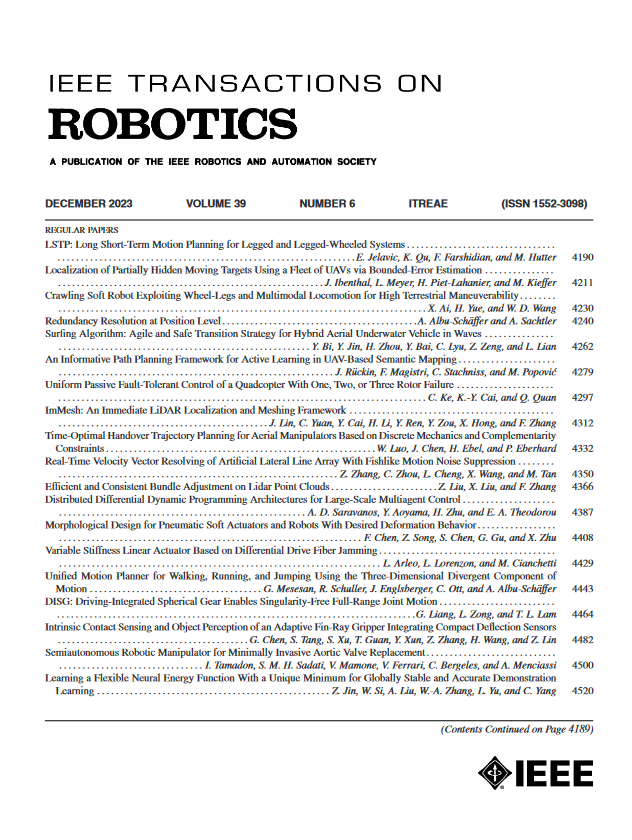A Wearable Isokinetic Training Robot for Enhanced Bedside Knee Rehabilitation
IF 9.4
1区 计算机科学
Q1 ROBOTICS
引用次数: 0
Abstract
Knee pain is prevalent in over 20% of the population, limiting the mobility of those affected. In turn, isokinetic dynamometers and robots have been used to facilitate rehabilitation for those still capable of ambulation. However, there are at most only a few wearable robots capable of delivering isokinetic training for bedridden patients. Here, we developed a wearable robot that provides bedside isokinetic training by utilizing a variable stiffness actuator and dynamic energy regeneration. The efficacy of this device was validated in a study involving six subjects with debilitating knee injuries. During two courses of rehabilitation over a total of three weeks, the average peak torque, average torque, and average work produced by their affected knees increased significantly by 81.0%, 101.4%, and 117.6%, respectively. Furthermore, the device's energy regeneration features were found capable of extending its operating time to 198 days under normal usage, representing a 57.8% increase over the same device without regeneration. These results suggest potential methodologies for delivering isokinetic joint rehabilitation to bedridden patients in areas with limited infrastructure.用于增强床旁膝关节康复的可穿戴等速训练机器人
膝关节疼痛在20%以上的人群中普遍存在,限制了患者的活动能力。同样,等速测力计和机器人也被用于帮助那些仍能行走的人康复。然而,最多只有少数可穿戴机器人能够为卧床不起的病人提供等速训练。在这里,我们开发了一种可穿戴机器人,通过利用可变刚度执行器和动态能量再生来提供床边等速训练。该装置的有效性在一项涉及6名膝关节损伤患者的研究中得到了验证。在为期三周的两个康复疗程中,患者患膝的平均峰值扭矩、平均扭矩和平均功分别显著增加了81.0%、101.4%和117.6%。此外,该设备的能量再生功能可以将其正常使用的工作时间延长至198天,比没有再生的相同设备增加了57.8%。这些结果提示了在基础设施有限的地区为卧床病人提供等速关节康复的潜在方法。
本文章由计算机程序翻译,如有差异,请以英文原文为准。
求助全文
约1分钟内获得全文
求助全文
来源期刊

IEEE Transactions on Robotics
工程技术-机器人学
CiteScore
14.90
自引率
5.10%
发文量
259
审稿时长
6.0 months
期刊介绍:
The IEEE Transactions on Robotics (T-RO) is dedicated to publishing fundamental papers covering all facets of robotics, drawing on interdisciplinary approaches from computer science, control systems, electrical engineering, mathematics, mechanical engineering, and beyond. From industrial applications to service and personal assistants, surgical operations to space, underwater, and remote exploration, robots and intelligent machines play pivotal roles across various domains, including entertainment, safety, search and rescue, military applications, agriculture, and intelligent vehicles.
Special emphasis is placed on intelligent machines and systems designed for unstructured environments, where a significant portion of the environment remains unknown and beyond direct sensing or control.
 求助内容:
求助内容: 应助结果提醒方式:
应助结果提醒方式:


